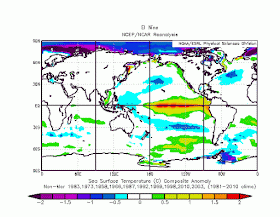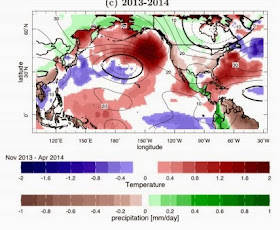After one of the warmest winters in Northwest history, a severely cold winter in the eastern U.S., and continued drought in California, the natural question is
why. Why have these conditions been present, with some subtle differences, during the past two winters?
As I have described in previous blogs (
here and
here), the proximate cause of the unusual weather has been a persistent ridge of high pressure (ridge) over the eastern Pacific and low pressure (trough) over the eastern U.S. Let me give you a better view of this by showing you the anomalies (differences from climatology) of heights of the 500 hPa pressure surface (located at around 18,000 ft) for the last two winter seasons (Nov through Feb). (see below) You can think of 500 hPa height like pressure (higher heights mean higher pressure, etc.) Blue colors indicate lower than normal heights (a.k.a., troughs) and yellow/orange suggest higher than normal heights (ridges).
You will note that both winters have a similar pattern with a line of alternating low and high pressures extending from near Hawaii to the north Atlantic. This is called
wave train and reflects a large scale atmospheric wave pattern emanating out of the tropics of the central Pacific. Both winters (2013-2014, 2014-2015) have ridging over the West Coast and troughing over the eastern U.S., but if you look closely there has been a subtle eastward shift of the pattern.
Last year's West Coast ridge was centered offshore and this year's ridge is nearly on the coast. This subtle shift has had its effects, such as causing this winter to be warmer over our region, with a bit more precipitation over California.
So the question of why our weather has been so unusual is really about the upper level wave train: why did it form? Why so strong this year? Why in in this configuration?
Fortunately, during the past few decades meteorologists have gained a deep knowledge of such wave trains, with much of the fundamental work done here at the University of Washington.
One early insight was that large areas of convection (thunderstorms) in the tropic Pacific Ocean, generally located over warmer than normal water, could create an atmospheric wave train that moved into the midlatitudes. You can think of the intense vertical motions in the tropical thunderstorms as big rocks dropped into a large (planetary) pond, with waves propagating away from the disturbed area (a young man below demonstrates this).
For example, we have learned when warm tropical Pacific waters shift eastward, with the big thunderstorms following---something known as
El Nino---the changes in the position of the wave train greatly influence West Coast weather, causing low pressure over the eastern Pacific and wetter conditions over California. Here are two plots: one showing the sea surface temperature anomaly during El Nino years and the second, the associated impacts (anomalies from normal of the 500 hPa heights, again around 18,000 ft) over the entire globe. The impact of the warm tropical water in the eastern Pacific are profound, including a deep low off (purple) of North America. La Nina events (colder water in eastern Pacific, warmer in the west) have the opposite effects.


El Nino and La Nina events (commonly called El Nino Southern Oscillation--ENSO--events) have demonstrated something profound to meteorologists: that sea surface temperature anomalies (areas of warmer or colder than normal temperatures) in the tropical Pacific have a huge impact on weather in the midlatitudes. Far more important than anything happening in the far smaller and less energetic polar regions. To put it another way, the tropics are in the driver's seat when it comes to major circulation changes in the atmosphere.
So what does this have to do with the wacky weather of the past two winters? Just about everything, as demonstrated by a series of recent research papers.
During the past two years there has been a sea surface temperature anomaly in the western tropical Pacific that strengthened and extended westward in 2015. Below are the sea surface temperature anomalies (difference from normal) for November to February of 2013-2014 and 2014-2015, with red and orange indicating much warmer than normal temperatures. In 2014, you can see the warmer than normal temperatures near the equator NE of Australia (and the warm BLOB off our coast). This year the warm waters extended eastward and the warm BLOB moved to our coast.
Several researchers, including
Saeger et al and
Hartmann 2015, to name just a few, have shown the including the observed tropical sea surface temperatures in numerical simulation models produced midlatitude wave trains (positions of highs and lows) very similar to observed. Here is an example from Seager et al., showing the winter 2013-2014 the sea surface temperatures anomalies (color shading over the oceans) used to forced the models. In turn, the model produced dry conditions over the West Coast and an upper level ridge (shown at 200 hPa, around 40,000 ft) along and just offshore of the West Coast, with a trough over the eastern U.S. Very similar to what was observed. Magic.
The key point is that the observed sea surface temperature distribution in the tropics can forced the observed anomalous weather patterns in the midlatitudes.
Dennis Hartmann's 2015 paper demonstrates this pattern reflect a mode of natural variability called the
North Pacific Mode. The positive phase of the North Pacific Mode has a sea surface distribution very much what we have seen the past two years (see figure below, which shows sea surface temperature anomalies for NPM years)
Professor Hartmann analyzed the observed magnitude of this mode over the past several decades (shown below). Note how it is has grown rapidly over the past two years. But also observe that no long-term trend is apparent. This suggests that the anomalous conditions are not reflecting global warming, which has revved up substantially over that period.
The bottom line of the bulk of the recent literature by top NOAA and university scientists is that the unusual conditions we have seen this year and last reflect natural variability, with much (but not all) of it associated with the North Pacific Mode. Thus our unusual weather is probably not the result of anthropogenic global warming, and it appears that trendy theories of the impacts of polar warming are probably without merit. The best news is that since it is natural variability one might expect that it will soon end.







.gif)






























.gif)










